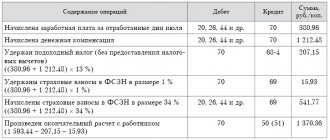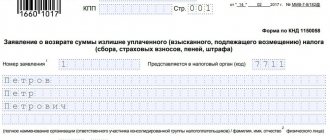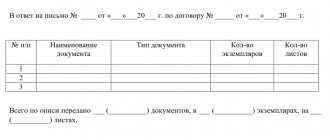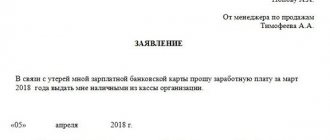Features of dismissal in the order of transfer to another organization
There are several options for dismissing transfer employees.
It all depends on who takes the initiative. If the head of this organization is ready to hire an employee, then he writes a letter of invitation addressed to the current head, where he confirms that he is ready to hire his employee.
This written notice will be mailed or personally delivered to the incumbent. If he agrees with the transfer, the employee writes a letter of resignation in the order of transfer, on the basis of which a dismissal order is issued, an entry is made in the work book, personal card, final payment is made, and documents are issued in person (work book and income certificate for 2 years). With them, the employee goes to a new place of work, where he is hired.
Also in this case, the subordinate writes a letter of resignation in his own hand, to which he attaches an invitation to work. Having considered the request, the manager endorses his decision.
There are times when an organization urgently needs to reduce its workforce or fire some staff. In this case, the employer can independently find a new place of work for the employee. Managers discuss all the nuances and receive written consent to the transfer from the employee. A tripartite agreement is signed, which specifies the position, salary, working conditions, etc. The standard transfer procedure follows.
Each of these options has its own characteristics. Therefore, any manager needs to know and be able to fill out all the necessary documentation.
Step 1 - request
The new employer makes a request to transfer the employee or the current employer sends a letter to the new employer requesting the transfer of the employee.
The employee writes a transfer application (he must agree with it). It is imperative to obtain the employee’s consent to the transfer; for this, he is sent a written proposal, which will indicate where it is proposed to transfer the employee, to what position and from what date.
If the employee does not mind, then the employer formalizes the dismissal by transfer to another organization; on the day of dismissal, an order is formed; the T-8 form can be used. In the order, in the “document basis” field, a letter of request from a new workplace, consent from the current place of work, the consent of the employee or his statement is indicated. In the “grounds” field, clause 5, part 1, article 77 of the Labor Code of the Russian Federation is indicated.
The payments due to the employee are calculated. In this case, the calculation note form T-61 is filled out. On the last day, the employee must be given a salary, vacation compensation, severance pay, if this is provided for by the company’s internal local regulations.
Based on the order, an entry about the termination of the employment contract is made in the work book (how to make an entry in the work book), as well as in the last section of the personal card.
According to the general rules, settlements with a dismissed employee are made on the day of his dismissal (Article 84.1 of the Labor Code of the Russian Federation). If the employee was not at work on that day, then the calculation is made no later than the next day after filing an application for payment of the amounts due to him (Article 140 of the Labor Code of the Russian Federation).
Separately, it is worth paying attention to the fact that if dismissal by way of transfer to another organization of an employee occurs during a period of temporary incapacity for work, then the employer will additionally have to pay for sick leave in accordance with the rules of Article 5 of the Law. In case of violations of labor legislation, the employee may qualify for compensation interest in the amount of 1/300 of the rate of the Central Bank of the Russian Federation.
Calculations are made based on the untimely paid amount (Article 236 of the Labor Code of the Russian Federation). Lack of funds at the enterprise cannot be a reason for violating the terms of payment of material compensation. If the employer continues to violate the rights of the employee, the latter can file a complaint with the labor inspectorate or file a claim in court.
The employee is given a work book, a 2-NDFL certificate, as well as a certificate of earnings for 2 years for calculating sick leave with the new employer.
After the current employer formalizes dismissal in connection with the transfer, the new employer is obliged to hire the dismissed person within a month without establishing a probationary period for him.
If a new employer applies for a transfer, he sends a request to the organization where the employee he is interested in works to consider this possibility. The letter usually contains the following information:
- last name, first name, patronymic and position of the specialist invited to work;
- date of expected hiring;
- vacancy for which a subordinate is invited.
The employing organization, having reviewed the letter, must respond with consent or refusal, as evidenced by the manager’s visa. Also on this request is the signature of the employee indicating agreement (or disagreement) with the proposed position.
If the decision is positive, the employer sends a response letter to the initiating party, which confirms both his and the employee’s consent. With this option for resolving the issue, an application from the employee is usually not required, but it is better if there is one.
What happens to the employee's vacation time? Since the employee has a new employment contract, in accordance with Art. 121 of the Labor Code of the Russian Federation, his vacation period begins to be calculated anew.
Do not forget that upon dismissal due to transfer from one organization to another, the employee has the right to compensation for unused vacation at the old place of work.
He will be able to receive his annual paid leave only after 6 months of work experience at the new place of work. There can be no exceptions. The only option that will help an employee take a vacation immediately after moving to a new place of work is to provide vacation on account of future periods (Article 122 of the Labor Code of the Russian Federation).
When dismissing an employee by transfer, on his initiative, it must be recorded in the work book that the transfer was executed at the request of the employee himself. This information is recorded in the work information column. This is the requirement of the Instructions, which regulate the rules for filling out work books.
In addition, when filling out a work book, it is important to adhere to the exact wording of dismissal, which is contained in the Labor Code. Otherwise, the entry will be considered invalid if executed in violation of the requirements
What happens to pensions and sick leave? To assign a pension, the insurance period is taken into account, and not the length of continuous work, so in this case nothing terrible happens. The situation is the same with sick leave; the amount of the benefit depends on the length of insurance coverage, so it will not change.
The process of transferring employees from one organization to another is not that complicated. The main thing is to correctly document the chronology of dismissal and hiring of employees, as well as obtain all the necessary signatures. The use of special unified order forms greatly facilitates paperwork.
"Maternity maids"
Sometimes a situation arises when an organization is liquidated, and it is necessary to transfer a woman to another employer while she is on maternity leave or to care for a child.
If the employee herself takes the initiative, or agrees to the proposed transfer, dismissal and hiring are carried out in the prescribed manner.
Young professionals
Labor law norms strictly regulate the impossibility of transferring a young specialist to a job other than the specialty he received.
If the transfer occurs due to the employer’s failure to fulfill its obligations, or for medical reasons, the loss of the young specialist’s status does not occur.
If such employee has written consent to transfer to another employer, and in cases where the transfer is initiated by the employee himself, the transfer is carried out according to the generally accepted algorithm.
If an employee moves to work from one branch of the company to another, and there is a different manager in each division, there is also a dismissal by transfer to another employer, since the employer’s representatives are different.
We thank our reader, Tatyana Aleksandrovna Skripova, chief accountant of Superfruit LLC, Syktyvkar, Komi Republic, for suggesting the topic of the article
Sometimes the owners of an organization divide the business, and along with it the employees. In this case, some of the workers can be transferred en masse either to an already existing or to a newly created company. With such a transfer, nothing may change for employees. They will continue to do their usual work, perhaps even in their previous jobs.
When preparing mass transfers, accountants often wonder: is there a way to do this with the least amount of documents? Let's look at how to correctly formalize such a “movement” of personnel from the perspective of labor legislation.
A transfer to another organization through a dismissal procedure can be initiated by the employee himself or by his employer (present or future). This form of transition, according to Art. 169 of the Labor Code of the Russian Federation, provides the following benefits:
- guaranteed execution of an employment contract with a new employer;
- payment of expenses associated with moving to another location for the employee and his family members.
When dismissed by transfer at the request of an employee, he needs to ask his future employer to issue a special letter of invitation to work in his organization (read how a transfer to another job within the company occurs at the employee’s initiative, read here).
This letter must contain specific information:
- last name, first name, patronymic of the employee invited to work;
- the position to which the employee is transferred;
- date of intended transfer;
- employer's signature and company details.
General information
Internal and external transfer to another job
Transfer from work to another can be both internal and external. This depends on the movement of employees within the organization or the release of job vacancies at other enterprises.
More details about translation:
- Internal involves changing jobs in the same organization. The employee has the right to move to another department or change position. This is possible only in agreement with the manager, but the only exceptions are unforeseen circumstances, for example, natural disasters, emergencies and other incidents.
- The concept of external transfer is the complete termination of an employment contract with an employer and the conclusion of an employment agreement with another within a month.
When an employee moves to another place, but if the company remains the same and dismissal is not required.
What happens if a manager refuses to let an employee go?
If an employee has expressed a desire to resign by transfer, but his employer is against this, then the employee has no choice but to leave of his own free will. In this case, the employee is left without protection before the new manager.
That is, if dismissal occurs due to transfer, then the receiving party must employ the employee within a month, otherwise he may go to court. By a court decision, they can either reinstate him to his previous place of work, or oblige the head of the receiving enterprise to hire this employee.
If the dismissal occurs at will, then there will be no one to file a claim with.
This version of the transfer procedure is similar to the previous one, so we will not repeat ourselves, but will talk about the differences and features of the transfer on the initiative of the manager.
- The heads of enterprises agree among themselves that one fires the employee, and the second hires. This can be confirmed by a letter of invitation (as in the first option).
- After this, the employee himself must be familiarized with the upcoming transfer. He must be told in writing about the position he will hold, the working conditions, and the salary amount. If an employee does not agree to a transfer, then no one can force him to change his job.
- After which the receiving party receives a confirmation letter.
- At an enterprise where an employee is fired, the manager issues a dismissal order, which states that the dismissal occurs with the consent of the employee. It is also necessary to refer to Article 77 of the Labor Code of the Russian Federation.
- After which, appropriate entries are made in the work book and personal card, which also indicate that the dismissal is carried out with the consent of the employee. A sample record of dismissal in the order of transfer in the work book was discussed earlier in the first version.
- All records and orders must be presented to the employee against his signature.
- A settlement is made with the payment of all compensation, after which a work book and a certificate of income for 2 years are issued.
The legislation provides for the responsibility of the employer for the period of delay (due to his fault) in the issuance of documents. The court assigns to the person who is guilty of illegal dismissal or transfer of an employee penalties that were incurred by the organization in connection with payment for absenteeism or unpaid labor by the employee.
Benefits for the employee:
- There are no probationary periods assigned at the new workplace.
- Employment within a period of one month.
Disadvantage for the employee:
- Leave is not saved.
Benefits for management:
- When laying off workers, it is necessary not to fire them, but to transfer them.
Disadvantages for management:
- Loses employees.
- The need to find new workers.
By a court decision, they can either reinstate him to his previous place of work, or oblige the head of the receiving enterprise to hire this employee. If the dismissal occurs at will, then there will be no one to file a claim with.
Dismissal due to transfer does not have any material consequences for the employer. This type of termination of employment differs only slightly from ordinary dismissal, for example, at will.
The only drawback in this case is the need to find a new employee, especially if a qualified specialist leaves. As for the paying employees, in this case the legislator obviously took care of protecting their legitimate interests.
Is it possible to refuse when transferring from one organization to another?
In Art. 72.1 of the Labor Code of the Russian Federation establishes that the transfer of an employee to another organization can only be carried out with his written consent or upon request. Moreover, in case of such dismissal, the current employment contract (agreement) is automatically canceled (Part 2 of Article 72.1 of the Labor Code of the Russian Federation). However, Art. 72.1 of the Labor Code of the Russian Federation establishes the possibility, but not the obligation, of the manager to satisfy the employee’s written request.
Thus, the employer has the right to refuse to dismiss his employee by way of transfer. However, such a refusal will not be considered an infringement of labor rights.
Translation processing procedure
We issue an order for dismissal in the order of transfer in the unified form T-8 with the wording “in the order of transfer at the request of the employee (or with the consent of the employee - depending on the situation) to work for another employer, paragraph 5 of part 1 of Article 77 of the Labor Code of the Russian Federation" .
As grounds for dismissal, we list the available documents (application (consent), invitation, tripartite agreement).
After the order is signed, we introduce it to the employee against his signature.
If your organization has approved its own forms of documents in the order on the budget accounting policy, then filling out these forms takes place in compliance with the general requirements.
All letters are written in any form. The application from the employee and the order from the manager must be drawn up in accordance with all the rules. Below we provide a table with which you can correctly draw up the necessary document.
| Application from an employee | 1. Name of the addressee; 2. Full name of the employee; 3. Title of the document (application); 4. The essence of the statement “Please fire me...”; 5. Date; 6. Signature. |
| Dismissal order (order) | 1. Name of the organization; 2. Name of the document and its number (Order No....); 3. Date of compilation; 4. Method of terminating the ore contract; 5. Full name of the dismissed employee; 6. Personnel number, position; 7. Basis for calculation; 8. Information about available documents that confirm the legality of dismissal due to transfer; 9. Date and signature of the manager; 10. The column “I have read the order,” where the resigning employee puts his signature. |
The employment contract is considered terminated after consideration of the resignation letter from the specialist. Administrative documents must have a clear structure and form, therefore the HR department of any enterprise stores the main forms of all administrative documents. If necessary, the employee can contact the HR department to obtain the necessary forms to fill out.
If at this stage the parties to the employment contract are satisfied with everything, they have no complaints against each other, then you can begin filling out the work book. This document remains with the employee, but the employee’s personal card must be at the enterprise. An employee card must be in T-2 form to be legally valid.
The calculation of an employee in the accounting department of the company is carried out along with the issuance of the following papers and documents:
- a certificate showing the total amount of accrued personal income tax;
- papers showing other areas of deductions from the enterprise and employee income.
Note! The date in the dismissal order is considered the official date along with which the employee ceased professional activities at a particular enterprise
Terms of transfer and relocation
Employers are required to adhere to labor laws. Therefore, they may not require any consent from their employees in order to carry out the move. But this is possible if certain conditions are taken into account. For example, the transfer is carried out without significant changes in working conditions for the employee.
While during a transfer, the employer does not have the right to force the employee to move to another department and take on additional responsibilities. This is against the law. Therefore, workers can only be transferred without consent in case of emergency. These conditions are specified in regulations. In addition, transfer is possible at the initiative of employees.
Most often, the reason for such a transfer is health or pregnancy.
Another reason for the transfer may be staff reduction. In this situation, the manager is obliged to offer the employee another suitable position for him. The transfer is carried out with the consent of the employee. It must be done in writing. Otherwise it is an illegal translation. If an employee refuses another job, the employment contract with him is terminated.
Author of the article
What happens if a manager refuses to let an employee go?
- The current employer receives a letter of invitation from an organization that is ready to hire his employee. It is drawn up in any form on the organization’s letterhead. It must indicate the position for which the employee is being hired and the approximate date of employment. Sometimes such a letter indicates the amount of the future salary, but this is not necessary.
- An employee who wants to transfer writes a statement addressed to the head of the organization stating that he wants to resign due to the transfer.
- After signing the application, a letter is sent to the organization that will employ the dismissed employee confirming the transfer. This item is optional, and the letter is drawn up for management’s consideration.
- Next, the head of the enterprise creates an order, where it is necessary to indicate on whose initiative the transfer is being carried out “In the order of transfer at the request of the employee.” In addition, the order must make reference to clause 5, part 1, article 77 of the Labor Code of the Russian Federation.
- After signing the order, it is registered in the Register of Orders for Personnel.
- The order must be communicated to the employee in writing.
- After this, in the employee’s personal card (T-2) on the fourth page, an entry is made about the employee’s dismissal, where a reference is also made to Art. 77 Labor Code of the Russian Federation. The employee must be familiar with all the records, after which he puts his signature on the card.
- After this, a corresponding entry is made in the employee’s work book, according to the Instructions for filling out the work book. There are 2 recording options:
- On the last working day, the employee is paid by issuing a settlement note (form T-61). Thus, the employee receives compensation for vacation and wages for days worked.
- After which the former employee is given a work book. An entry about this must be made in the Book of Accounting for the Movement of Labor Books, where the employee puts his signature.
- In addition to the work book, a certificate of salary for 2 months is issued.
- After this, the dismissed employee is obliged to find a new job within 1 month.
- When registering at a new location, a note is made in all relevant documents that it has been accepted for transfer.
- Based on the employee’s application, previously approved by the head of the organization by putting a positive resolution on it, it is necessary to issue an appropriate order. The unified form of such a document is T-8. The reasons for the document should be:
- existing application;
- invitation to a new job;
- tripartite agreement (if any).
- The HR service employee fills out a special form T-2 card, where on page 4 it is necessary to note the grounds for which the employee was dismissed.
- A record of dismissal is made in the work book according to the existing rules for filling out work books. When making an entry in this document, under no circumstances should you abbreviate the words! Don’t forget to give this book to the employee for signature.
- On the last working day, the final payment is made to the employee.
What should an employer indicate in its administrative document? Here is a list of required data:
- Name of the organization;
- name and number of the order;
- Date of preparation;
- method of terminating the employment contract;
- surname, name, patronymic of the employee;
- position, personnel number;
- basis for calculation;
- information about documents confirming the legality of dismissal;
- date, director's signature.
Please note that at the very end of the document there must be a note from the employee about familiarization. Below is a sample of this document
Recording in the work record can be done in one of the following options:
- “dismissed due to transfer at the request of the employee (or with the consent of the employee - depending on the situation) to work for another employer, paragraph 5 of part 1 of Article 77 of the Labor Code of the Russian Federation”;
- “the employment contract was terminated due to a transfer at the request of the employee (or with the consent of the employee, depending on the situation) to work for another employer, clause 5 of part 1 of article 77 of the Labor Code of the Russian Federation.”
Is vacation saved?
When an employee comes to work at a new place of work, his leave is not saved. He can go on vacation no earlier than in 6 months. The exceptions are:
- Going on maternity leave;
- If the dismissed employee is under 18 years of age;
- Registration of leave by an employee who is the adoptive parent of a child under 3 months.
From the moment of admission to the new company, the employee’s vacation period will begin to be calculated again according to Art. 127, art. 121 Labor Code of the Russian Federation. As you know, the right to vacation for the first year of work in a new company arises 6 months after the start of work in the new company. 122 Labor Code of the Russian Federation. There are no exceptions to this rule for transferred employees.
As already mentioned, upon dismissal, the employee is entitled to compensation for the period of unused vacation. As a result, the law does not provide for the continuation of leave upon transfer. This is due to the fact that the legislator equated the calculation of the transfer to a regular dismissal. Therefore, at a new workplace, an employee can receive leave no earlier than after 6 months (Article 122 of the Labor Code of the Russian Federation). An exception may be:
- going on maternity leave;
- granting dismissal to persons under 18 years of age.
- going on leave by employees who have adopted children no older than 3 months.
Concept
Transfer to another place of work is a temporary or permanent change in the duties that an employee performs at the workplace.
When transferred to another workplace, the employee does not leave his employer, only his type of activity changes.
In some cases, transfer involves redistribution to a neighboring locality.
When is transfer to another job allowed?
Transferring an employee to a new job is permitted in the following cases:
reduction or increase in staff;- winding down the activities of an enterprise in a given locality or opening new branches or production facilities;
- employee career advancement;
- medical restrictions for the employee;
- forced removal of an employee from his position.
Who can be dismissed by transfer?
Any employee can be fired in this way if they have given their consent or taken the initiative on their own. This category also includes single mothers, mothers of many children, women on maternity leave, etc.
Any employee can be fired in this way if they have given their consent or taken the initiative on their own. Single mothers, mothers of many children, women on maternity leave, etc. fall into this category.
Advantages and disadvantages of dismissal
We will consider all the positive and negative aspects of dismissal due to transfer in the table.
| Advantages | Flaws | |
| For employee | 1. No probationary period is established at the new place; 2. Mandatory employment within 1 month; | 1. Leave is not saved |
| For the manager | 1. When staffing is reduced, the employee is not fired, but transferred. | 1. Loss of specialists; 2. Search for new personnel. |











